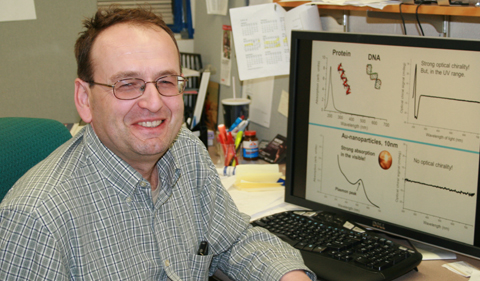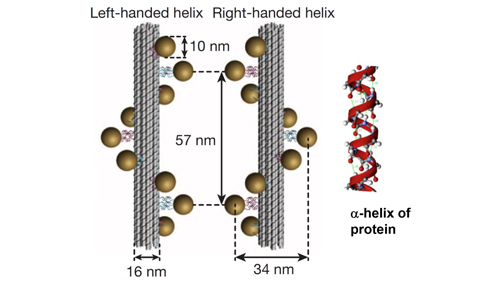
Distinguished Professor Alexander Govorov
At the spring 2016 commencement, it was announced that Alexander “Sasha” Govorov would be Ohio University’s next Distinguished Professor. He joined Ohio University in 2002 as an Associate Professor and is an esteemed researcher on the theory of optical properties of nanomaterials.
Govorov’s interests concern nanocrystals and biomolecules and their interaction with light and heat. Being initially an expert in low-temperature physics of nanostructures, He changed his research field when he moved from Russia to the United States, starting very active collaborations with researchers working in chemistry and biochemical engineering.
Since coming to the U.S., Govorov has published over 100 papers with theoretical predictions that have been realized by many groups worldwide. One of his more famous theoretical predictions is that a chiral biomolecule should interact with metal nanocrystals so as to create special chiral fingerprints in the optical spectra. This had never been seen experimentally before. Indeed, his prediction was shown to be true when such chiral optical signatures were then reported later by many experimental groups.

Chiral assembly made of DNA molecules and gold nanoparticles that exhibit plasmon resonances. This plasmonic helix exhibits very strong optical responses for circularly-polarized light. The right panel is a helical protein that motivated the idea of the plasmonic helix.
Govorov’s papers also established the theoretical foundations of two new fields of research in plasmonics (the study of collective oscillations of electrons in a material induced by light). One new field is called chiral plasmonics, and the other concerns the effects of plasmonic photoheating in collections of nanocrystals illuminated by light. This regime of the photo-thermal effect is now used conveniently by many research groups for creation of phase transformations of research in plasmonics (the study of collective oscillations of electrons in a material induced by light). One new field is called chiral plasmonics, and the other concerns the effects of plasmonic photoheating in collections of nanocrystals illuminated by light. This regime of the photo-thermal effect is now used conveniently by many research groups for creation of phase transformations at the nanoscale, i.e. a melting of biomolecules, and other applications.
The goal of a microscopic theory of collective excitations of metal nanocrystals, so-called plasmons, is to understand and control photochemical applications. Govorov’s recent publications, in the prestigious journal Nature, describe the phenomenon of generating of electron emission in specially-designed nanostructures with plasmonic hot spots, where this effect becomes strongly amplified. The bottom line is that there are new applications in optical control of chemical reactions that are now possible due to the theoretical ideas first described by Govorov.



















Comments